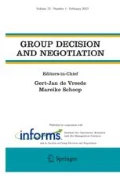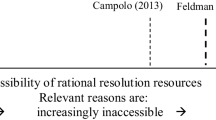Abstract
In this study we investigated the nature of disagreement, which is a necessary component of a good discussion. We obtained 27 group discussion scenes by Japanese undergraduates that were evaluated by two ways: impression rating and ranking. As a result of factor analysis for the impression rating data, five factors were extracted: activeness, multidirection and unification of discussion, relationships of participants, development and sophistication of discussion, and sincerity of the participants, and each factor scores of each scene was simultaneously calculated. Each scene’s rank score was also calculated by relative comparisons. A significant positive correlation was found between the mean factor and the rank scores except for Factor 3 (relationships of participants). To consider the reason for the difference relating to Factor 3’s score, we scrutinized the discussion process of four scenes of the different patterns of the factor and rank scores. From the analysis of conversations, we suggested that this difference reflected ways of disagreement. By introducing a probative discourse tags for discussion (pDTD), we reasoned that the frequency of disagreement made Factor 3’s score negative and the absence of the second part of adjacency pairs made the rank score worse. The explicit speech and actions of blame such as emotional and aggressive expression, and neglect of treatment for the minor opinion made also the discussion unfair, but we think that these behaviors might erupt from the ground made by the accumulated implicit behaviors such as the absence of the second part. We finally concluded that the criticism type of disagreement increased the rank scores, and its censure type produced lower results, and the proper ways of disagreement in group discussions were discussed.
Similar content being viewed by others
References
Araki M, Itoh T, Kumagai T, Ishizaki M (1999) Proposal of a standard utterance-unit tagging scheme. J Jpn Soc Artif Intell 14(2): 251–260
Bunt H (2007) Dialogue Act Annotation. In the presentation on ISO-SIGSEM joint working group meeting. http://www.tc37sc4.org/new_doc/ISO_TC37_SC4_N340_TDG3_DialogueActs_Bunt.pdf
Core MG, Allen JF (1997) Coding dialogs with the DAMSL annotation scheme. In Working Notes of the AAAI Fall Symposium on Communicative Action in Humans and Machines. http://citeseer.ist.psu.edu/core97coding.html
Coulthard RM (1985) An introduction to discourse analysis, 2nd edn. Longman
Galley M, McKeown K, Hirschberg J, Shriberg E (2004) Identifying agreement and disagreement in conversational speech: use of Bayesian networks to model pragmatic dependencies. In: Proceedings of the 42nd Annual Meeting on Association for Computational Linguistics
Hall J (1971) Decisions, Decisions. Psychology Today, November l971
JSAI (2002) Japanese Slash labelling manual ver. 2.0.1. The Working group of corpus using for discourse and dialogue study ed, JSAI (The Japanese Society for Artificial Intelligence)
Kitagawa T, IYO (2005) FINRANDMESODDO NYUMON (Introduction to Finland Method). Keizaikai
Kobayashi T (2007) TORANSUSAIENSUNO-JIDAI (The Epoch of Trans-Science). NTT Publishing Co
Levinson SC (1983) i. Cambridge University Press
Meteer M et al (1995) Disfluency Annotation Stylebook for the Switchboard Corpus. Linguistic Data Consortium, Revised 1995 by Taylor, A
Morimoto I, Mizukami E, Suzuki K, Otsuka H, Isahara H (2006) An exploratory study for evaluating and analyzing interactional processes of group discussion: The case of a focus group interview. J Human Interface Soc 8(1): 117–128
Pomerantz A (1984) Agreeing and disagreeing with assessments: some features of preferred/dispreferred turn shapes. In: Atkinson JM, Heritage J (eds) Structures of social action. Cambridge University Press, pp 57–101
Schegloff EA, Sacks H (1973) Opening up closings. Semiotica 8: 280–237
Suzuki K, Morimoto I, Mizukami E, Otsuka H, Isahara H (2007) An exploratory study for analyzing interactional processes of group discussion: The case of a focus group interview, AI & Society. (in printing)
Vaughn S, Schumm JS, Sinagub JM (1996) Focus group interviews in education and psychology. Sage Publications, Inc
Author information
Authors and Affiliations
Corresponding author
Rights and permissions
About this article
Cite this article
Mizukami, E., Morimoto, I., Suzuki, K. et al. Two Types of Disagreement in Group Discussions of Japanese Undergraduates. Group Decis Negot 18, 279–298 (2009). https://doi.org/10.1007/s10726-008-9152-8
Received:
Accepted:
Published:
Issue Date:
DOI: https://doi.org/10.1007/s10726-008-9152-8




